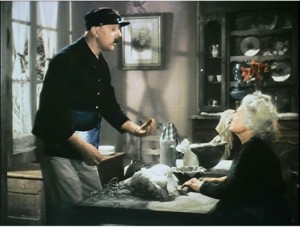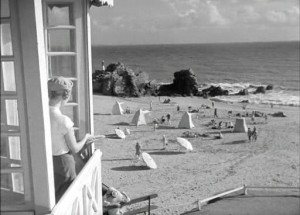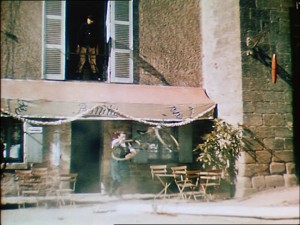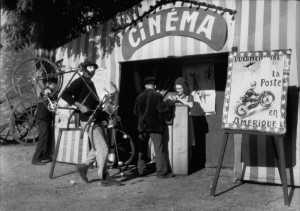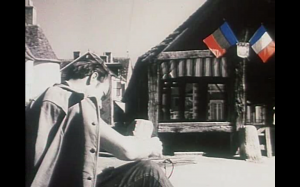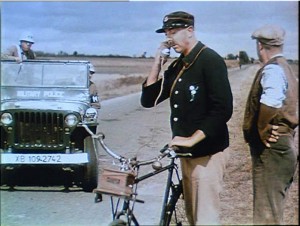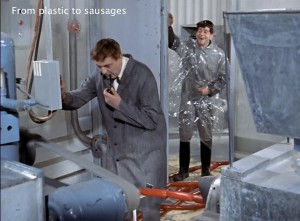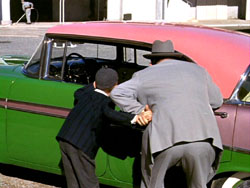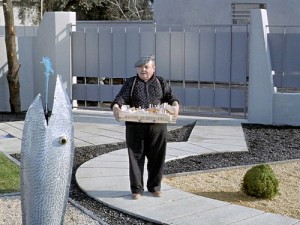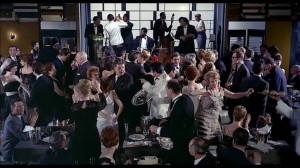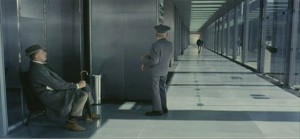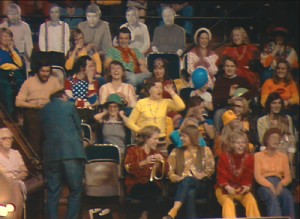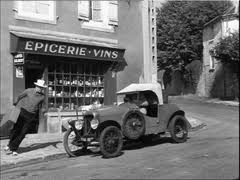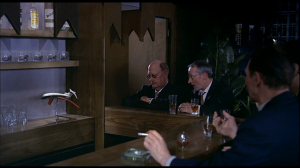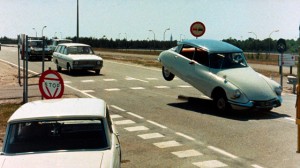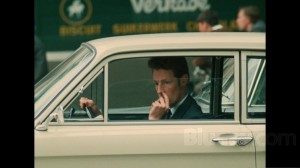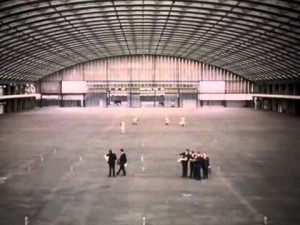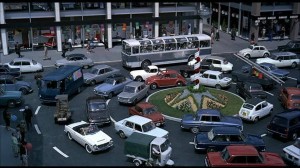Written in Summer 2014 for the seven-disc Criterion Blu-Ray box set, “The Complete Jacques Tati”, and posted on Criterion’s web site on October 28. — J.R.
Even though he was a skilled pantomimist, it’s impossible to imagine Jacques Tati as a film artist without his use of sound, and it’s not always easy to imagine his filmic universe minus color: two of his six features exist in black and white, but only the second of these, Monsieur Hulot’s Holiday (1953), was intended exclusively for that format. Tati had a sense of design in terms of both sound and image that expressed itself in painterly “touches” — strategic dabs that informed and inflected his overall compositions. (This shouldn’t be too surprising from the grandson of the man who framed van Gogh’s canvases.)
The fact that he always shot his films without sound and composed his soundtracks separately made it easier for him to use images and sounds interactively, employing sound in part as a way of guiding how we look at his images, by stimulating and directing our imaginations. This means that any discussion of Tati’s mise en scène has to cope with the reality that he effectively directed each of his films twice — once when he shot them and then once again when he composed and recorded their soundtracks. Adding sound often served as a way of “retouching” his images by directing our eyes, sometimes by complicating or even undermining the visual evidence. French film analyst Michel Chion has suggestively pointed out, for example, that if we listen to one of the naturalistic beach sequences in Monsieur Hulot’s Holiday without the image to “mislead” us, the apparent boredom, discomfort, and inertia of adult vacationers trying to figure out what to do becomes the sound of lively children enjoying themselves.
Tati often used color in much the same way, as another form of indirect direction. Both of his first two features are commonly known to us in black and white, but in the case of Jour de fête, this is only by default. The film was conceived and originally shot in a new, experimental color process known as Thomson-Color, which Tati found himself unable to develop afterward; having shot the film in 1949 with two cameras — one of them using black and white as a safeguard, in case the color process didn’t pan out — he wound up releasing the film in black and white. But when he reedited it and remixed the soundtrack in 1964, he also colored a few stray visual details with stencils. He even went back to the village of Sainte-Sévère-sur-Indre to shoot new material involving an added character, a young artist who can be seen painting some of the festivities, and went to the trouble of having this character’s art hand–colored on the film. Five years after Tati’s death, when his daughter Sophie Tatischeff joined forces with cameraman François Ede to lick the problem of processing Thomson-Color — which they finally accomplished with the film’s original negative only seven years later, in 1995 — she decided to eliminate this artist figure from her edit because she thought he was no longer needed. This is why we currently have three versions of Jour de fête, each with its own legitimacy.
In Mon oncle (1958), the red plastic tubing in Charles Arpel’s factory and the hideous three-tone pink, green, and lavender car he buys to celebrate his wedding anniversary are both part of the film’s social satire, but no less characteristically, Tati’s artistry was guided by practicalities when he discovered that he had to make the water that spouted from the grotesque fish fountain in Arpel’s rock garden dark blue simply in order to make it visible. By contrast, the first half of PlayTime (1967), emphasizing the sterility of glass and steel in modern architecture as well as the spatial confusions brought about through glass reflections, is mainly monochromatic, and the progressive humanizing of this landscape is partly introduced and enhanced through festive colors. Trafic (1971) begins by contrasting the cool industrial colors of a car factory (mainly blue and gray) behind the credits with the humanizing warmth of a few red accents (and a whistled musical theme) to introduce Hulot ambling through Paris’s Latin Quarter. In Parade (1974), one finds in the circus audience an array of curious life-size black-and-white photographs of seated spectators mounted on boards that are decorated with actual colored scarves and hats — a weird variant of the cardboard extras and photographed steel panels from Orly Airport used in the background of certain shots in PlayTime. (In both Trafic and Parade, there’s also an occasional association of bright colors with the playful improvisations and apparel of hippies.)
Tati’s sense of sound and image design always encompasses a certain distance from his subjects that implies observation rather than confrontation — an invitation to playfully map out our own itineraries. In PlayTime’s hour-long restaurant sequence, the most sublime and complex achievement of his mise en scène, the improvised paths of our own gaze even become part of the jubilant dancing. Close-ups (whether visual or aural) are absent, and this obviously has some relevance to the limited appearances of private spaces in his films. (The only partial exception is when characters are seen in their cars in Trafic, but as Abbas Kiarostami has often shown in his own films, such people inhabit public spaces even when they behave privately.) The coexistence of long shots and public spaces helps to determine the principles behind Tati’s compositions, which often interrelate left and right, and/or up and down and use sound and/or color as partial guides to how to identify and playfully navigate those interrelations.
Consider, in Jour de fête, our introduction to François the postman (Tati) on his bike, dodging an invisible wasp in the background while a hay mower in the foreground tries to decode his zigzagging movements — until the same wasp menaces the mower a moment later, turning him from a spectator into a comic victim himself. Or, in Monsieur Hulot’s Holiday, the way that we’re introduced to the title hero through the loud sputtering of his rickety, old-fashioned car before we ever see him. In a similar manner with color, in PlayTime, when the wings of a model plane behind the bar of an overheated, crowded restaurant start to droop, Tati ensures that we notice this tiny detail amid all the hubbub by making the wings red.
Tati’s highly original approach to dialogue, more often overheard than heard in any conventional manner, has been best described by the great André Bazin (quoted here in Timothy Barnard’s translation):
It has sometimes been mistakenly said that [Monsieur Hulot’s Holiday’s] soundtrack is made up of a kind of magma of sound on which snatches of sentences float, some of whose words are distinct while just as many others are nonsensical. This is nothing more than the impression of an inattentive ear. In fact, the film’s soundtrack is rarely indistinct, except for the loudspeakers on the train platform—but then this gag is realistic. On the contrary, all of Tati’s artfulness consists in destroying clarity with clarity. The dialogues are not at all incomprehensible; rather, they are insignificant, and their insignificance is revealed by this very clarity. Tati achieves this by deforming the intensity of the various levels of sound, sometimes going so far as to maintain the sound of an offscreen action over a scene shot silent. For the most part, his sound decor is made up of realistic elements: bits of conversations, cries, various kinds of remarks. None, however, is strictly located in a dramatic situation. In relation to this background noise, sudden noises take on an entirely false prominence.
Bazin goes on to give as an example of this the exaggerated offscreen sound of Monsieur Hulot playing Ping-Pong, which disrupts the hotel guests’ more quiet activities in the evening.
One of the most telling phrases here, offering an important clue to what makes Tati so distinctive, is “sound decor.” We usually think of decor as something designed and built rather than as a “found” element, but in Tati it’s usually both. The fact that Monsieur Hulot’s Holiday was mainly shot at an actual seaside resort shouldn’t mislead one into thinking that it wasn’t partially designed and built as well. The facades of both the Hôtel de la Plage and the house where the character Martine stays are constructed sets, and the paradoxical reason for this was to make the film more “realistic.” The Hôtel de la Plage was a real hotel, and Tati insisted on shooting much of his film there while it went about its normal operations. But in order to do this without interfering too much with those operations, a fake front where he could shoot many scenes also had to be built. In short, even the manufactured decor in Tati’s world is meant to be observed and discovered rather than simply noticed. And the subtle mix of real and artificial elements applies equally to the soundtrack, as Bazin was among the first to observe. Similarly, the mix of documentary chance and fictional construct — especially prominent in Trafic and Parade, and climaxing in the unsupervised play of two very young children with circus props at the end of the latter film — is no less intricate. One might guess that some nose-pickers in Trafic were caught with a candid camera while others were directed to behave that way, but however they were “captured,” Tati’s parallel editing of them is very much a construction, musically — as well as plastically — organized.
Thus, Jean-Luc Godard’s witty remark in 1957 that, with Tati, “French neorealism was born” needs to be read with the understanding that expressionism in both sound and image is sometimes needed to create a “neorealistic” (or “realistic”) effect. Bazin’s example of the loudspeaker on the train platform is still another instance of expressionistic sound used for the same purpose, and the climactic highway pile-up in Trafic is another fine illustration of composing action using chance as well as control.
Broadly speaking, we can subdivide Tati’s half dozen features into two clusters: three with relatively conventional narratives and characters (Jour de fête, Mon oncle, Trafic) and, in alternation and contrast with these, three radical works that virtually reinvent some of the basic elements of film language (Monsieur Hulot’s Holiday, PlayTime, Parade). And what gets reinvented in those three involves what we usually mean by “film subject” — or, put more simply, content. This content is suggested by the films’ titles: Not simply Monsieur Hulot but his holiday. Not play or time but a combination of these two concepts, expressed both as nouns and as verbs. And, somewhat more obscurely (but no less profoundly), not merely parade as “pompous show” or “public procession” (to cite two of my Merriam-Webster’s definitions), but also “a place for strolling” and “those who promenade” (to cite two others), and even (as a verb) “to cause to maneuver or march” — a parade, in short, where it becomes impossible to separate audience from performer or determine where and at what point spectacle ends and life begins (or vice versa).
Needless to say, all three of these subjects are related to one another, and relevant to every Tati feature — as are the titles Jour de fête and Trafic. Only Mon oncle breaks with this pattern by pointing to a character rather than the context he inhabits; but even here, it’s the interactions between Hulot and his environment that are the film’s actual focus. The bottom line is that what we do and experience — as spectators, listeners, and observers, as respected partners in the mise en scène — are ultimately the true subjects of Tati’s work. “PlayTime is nobody,” he once said to me in an interview, specifically to distinguish his film from Fellini’s Roma. But he might just as well have said that PlayTime is everybody, meaning us.
Jonathan Rosenbaum worked briefly with Tati in 1973 as a script consultant on his unrealized film Confusion. He contributed seven essays to a volume on Tati from Taschen Books, and “The Dance of ‘PlayTime’” to the Criterion Collection’s separate edition of that film.

